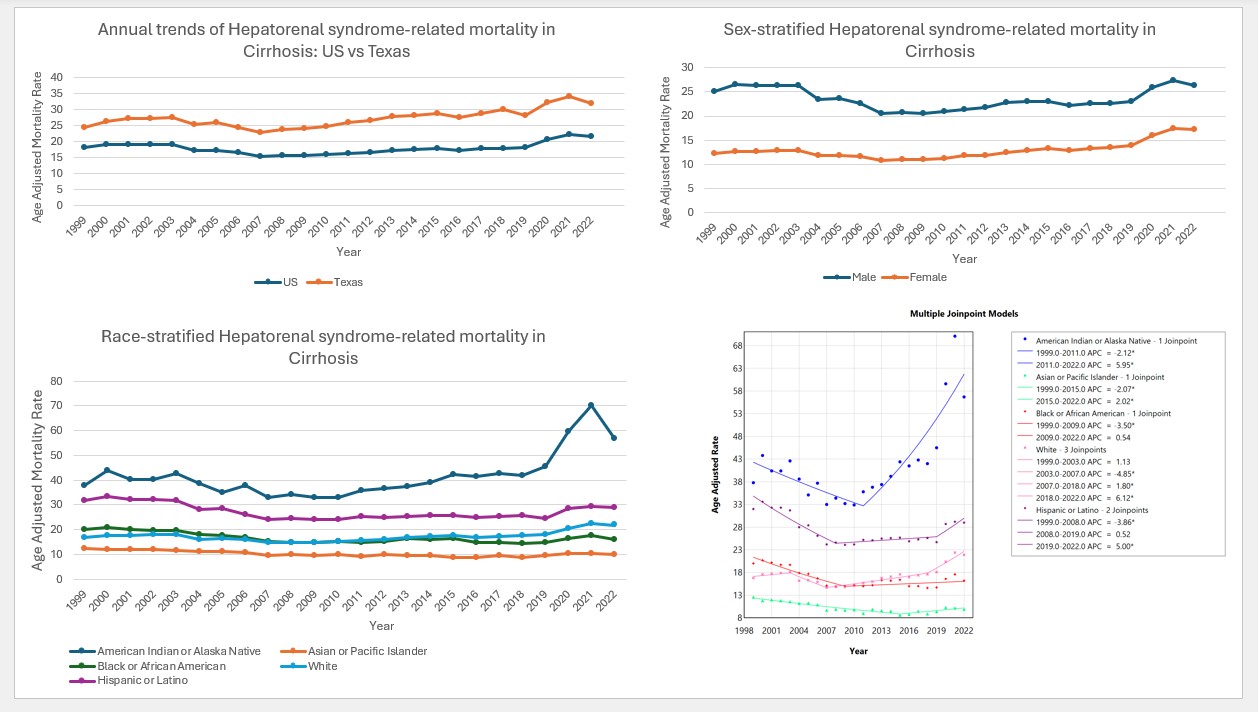Monday Poster Session
Category: Liver
P3773 - Trends and Sociodemographic Disparities in Hepatorenal Syndrome Mortality Among Adults With Cirrhosis: A 23-Year Observational Study (1999–2022)
Monday, October 27, 2025
10:30 AM - 4:00 PM PDT
Location: Exhibit Hall

Sidra Naz, MD, MPH
University of Texas MD Anderson Cancer Center
Houston, TX
Presenting Author(s)
Sidra Naz, MD, MPH1, Maitri Shah, MD2, Amey Joshi, MD2, Shazia Khan, MD3, Nirmit Patel, MBBS4, Adarsh Kumar. Jha, MD2
1University of Texas MD Anderson Cancer Center, Houston, TX; 2University of Michigan Health - Sparrow, Lansing, MI; 3BronxCare Health System, New York, NY; 4St. Mary's General Hospital, New York Medical College, Denville, NJ
Introduction: Hepatorenal syndrome (HRS) is the third leading cause of admission in patients with cirrhosis and is associated with high mortality. This study aims to estimate the mortality rates across various demographic (sex, race/ethnicity, age) and geographic (state, urban-rural, regional) subgroups
Methods: Mortality trends for adults age ≥25 years were analyzed using the CDC WONDER database data, identifying deaths through ICD-10 codes K76.7 “Hepatorenal syndrome” and K74 “Cirrhosis.” Crude and age-adjusted mortality rates (AAMRs) per 100,000 and annual percent changes (APCs) with 95% confidence intervals were analyzed.
Results: Between 1999 and 2022, 968556 documented deaths were attributed to HRS in patients with cirrhosis in the United States. The overall AAMR for HRS-related mortality increased in the US from an adjusted rate (AR) 18.2 in 1999 to 21.5 in 2022 (APC: 0.79%; 95% CI: 0.49% to 1.17%). In Texas, AAMR increased from AR 24.5 in 1999 to 31.7 in 2022 (APC: 1.22%; 95% CI: 0.74% to 1.74%). Males had consistently higher AAMRs than females (26.3 vs. 17.2). The AAMR in U.S. men increased from 25.1 in 1999 to 26.3 in 2022 (APC: 0.16%; 95% CI: -0.21% to 0.75%). The AAMR in U.S. women increased from 12.2 in 1999 to 17.2 in 2022 (APC: 1.44%; 95% CI: 1.16% to 1.71%). The non-Hispanic (NH) American Indian or Alaska Native population had the greatest AAMR (56.7), followed by the Hispanic or Latino (29) and NH White population (21.9). Lower-risk groups were NH Black or African American (AA) (16.2) and NH Asian or Pacific Islander (9.9). AAMR also varied by region (South: 23.9; West: 19.8; Midwest: 19.3; Northeast: 15.8). Non-metropolitan areas had higher AAMR (small metro: 23.1; non-core areas: 26.3; micropolitan areas: 25.6) than metropolitan areas (large central metropolitan areas: 18.3; large fringe areas: 17.2). The states in the upper 90th percentile of AAMRs were Texas, Wyoming, Indiana, Oklahoma, with approx. two-fold increase in AAMRs, compared to states falling in the lower 10th percentile, Nebraska, Iowa, Wisconsin, Illinois, and New York.
Discussion: Mortality rates from HRS have risen overall in the U.S. over the past two decades. NH American Indian or Alaska Native, Hispanic or Latino, and NH White men remain at high risk, emphasizing the need for further investigation into effective prevention and treatment strategies.

Figure: Annual Trends of Hepatorenal syndrome-related mortality in Cirrhosis in the United States (1999–2022)
Disclosures:
Sidra Naz indicated no relevant financial relationships.
Maitri Shah indicated no relevant financial relationships.
Amey Joshi indicated no relevant financial relationships.
Shazia Khan indicated no relevant financial relationships.
Nirmit Patel indicated no relevant financial relationships.
Adarsh Jha indicated no relevant financial relationships.
Sidra Naz, MD, MPH1, Maitri Shah, MD2, Amey Joshi, MD2, Shazia Khan, MD3, Nirmit Patel, MBBS4, Adarsh Kumar. Jha, MD2. P3773 - Trends and Sociodemographic Disparities in Hepatorenal Syndrome Mortality Among Adults With Cirrhosis: A 23-Year Observational Study (1999–2022), ACG 2025 Annual Scientific Meeting Abstracts. Phoenix, AZ: American College of Gastroenterology.
1University of Texas MD Anderson Cancer Center, Houston, TX; 2University of Michigan Health - Sparrow, Lansing, MI; 3BronxCare Health System, New York, NY; 4St. Mary's General Hospital, New York Medical College, Denville, NJ
Introduction: Hepatorenal syndrome (HRS) is the third leading cause of admission in patients with cirrhosis and is associated with high mortality. This study aims to estimate the mortality rates across various demographic (sex, race/ethnicity, age) and geographic (state, urban-rural, regional) subgroups
Methods: Mortality trends for adults age ≥25 years were analyzed using the CDC WONDER database data, identifying deaths through ICD-10 codes K76.7 “Hepatorenal syndrome” and K74 “Cirrhosis.” Crude and age-adjusted mortality rates (AAMRs) per 100,000 and annual percent changes (APCs) with 95% confidence intervals were analyzed.
Results: Between 1999 and 2022, 968556 documented deaths were attributed to HRS in patients with cirrhosis in the United States. The overall AAMR for HRS-related mortality increased in the US from an adjusted rate (AR) 18.2 in 1999 to 21.5 in 2022 (APC: 0.79%; 95% CI: 0.49% to 1.17%). In Texas, AAMR increased from AR 24.5 in 1999 to 31.7 in 2022 (APC: 1.22%; 95% CI: 0.74% to 1.74%). Males had consistently higher AAMRs than females (26.3 vs. 17.2). The AAMR in U.S. men increased from 25.1 in 1999 to 26.3 in 2022 (APC: 0.16%; 95% CI: -0.21% to 0.75%). The AAMR in U.S. women increased from 12.2 in 1999 to 17.2 in 2022 (APC: 1.44%; 95% CI: 1.16% to 1.71%). The non-Hispanic (NH) American Indian or Alaska Native population had the greatest AAMR (56.7), followed by the Hispanic or Latino (29) and NH White population (21.9). Lower-risk groups were NH Black or African American (AA) (16.2) and NH Asian or Pacific Islander (9.9). AAMR also varied by region (South: 23.9; West: 19.8; Midwest: 19.3; Northeast: 15.8). Non-metropolitan areas had higher AAMR (small metro: 23.1; non-core areas: 26.3; micropolitan areas: 25.6) than metropolitan areas (large central metropolitan areas: 18.3; large fringe areas: 17.2). The states in the upper 90th percentile of AAMRs were Texas, Wyoming, Indiana, Oklahoma, with approx. two-fold increase in AAMRs, compared to states falling in the lower 10th percentile, Nebraska, Iowa, Wisconsin, Illinois, and New York.
Discussion: Mortality rates from HRS have risen overall in the U.S. over the past two decades. NH American Indian or Alaska Native, Hispanic or Latino, and NH White men remain at high risk, emphasizing the need for further investigation into effective prevention and treatment strategies.

Figure: Annual Trends of Hepatorenal syndrome-related mortality in Cirrhosis in the United States (1999–2022)
Disclosures:
Sidra Naz indicated no relevant financial relationships.
Maitri Shah indicated no relevant financial relationships.
Amey Joshi indicated no relevant financial relationships.
Shazia Khan indicated no relevant financial relationships.
Nirmit Patel indicated no relevant financial relationships.
Adarsh Jha indicated no relevant financial relationships.
Sidra Naz, MD, MPH1, Maitri Shah, MD2, Amey Joshi, MD2, Shazia Khan, MD3, Nirmit Patel, MBBS4, Adarsh Kumar. Jha, MD2. P3773 - Trends and Sociodemographic Disparities in Hepatorenal Syndrome Mortality Among Adults With Cirrhosis: A 23-Year Observational Study (1999–2022), ACG 2025 Annual Scientific Meeting Abstracts. Phoenix, AZ: American College of Gastroenterology.
